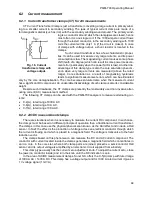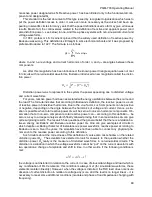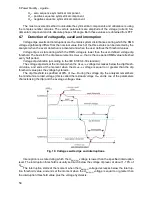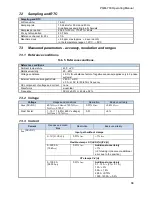
6 Power Quality - a guide
55
showed very high RMS current. Explanation of this phenomenon is however rather simple. In this
example, the designer did not take into consideration two circumstances: in systems with distorted
waveforms, the higher harmonics might not zero in the neutral conductor, and quite to the contrary,
they may sum up, and secondly, the skin effect and high harmonic currents additionally contributed
to the neutral conductor heating.
Let us try now to answer two basic questions:
What is the cause of harmonic components in voltage?
What is the cause of harmonic components in current?
Seemingly, these two questions are almost identical, but separation of current and voltage is
extremely important to understand the essence of this issue.
The answer to the first question is as follows: harmonics in voltage are a result on a non-zero
impedance of the distribution system, between the generator (assuming that it generates a pure
sinusoid) and the receiver.
Harmonics in current, on the other hand, are a result of non-linear impedance of the receiver.
Of course, it must be noted that a linear receiver to which distorted voltage is supplied will also have
identically distorted current waveform.
For years, in the literature th
e following statement has been used “receiver generates harmon-
ics”. It should be remembered that in such case, the receiver is not a physical source of energy (as
suggested by the word “generates”). The only source of energy is the distribution system. If the
receiver is a passive device, the energy sent from the receiver to the distribution system comes
from the same distribution system. What we have here is a disadvantageous and useless bidirec-
tional energy flow. As discussed earlier in the section on power factor, such phenomenon leads to
unnecessary energy losses, and the current “generated” in the receiver causes an additional load
on the distribution system.
Let us consider the following example. A typical non-linear receiver, such as widely used
switched-mode power supplies (i.e. for computers) receives power from a perfect generator of si-
nusoidal voltage. For the time being, let us assume that the impedance of connections between the
generator and the receiver is zero. The voltage measured on the receiver terminals will have sinus-
oidal waveform (absence of higher harmonics)
– this is imply the generator voltage. The receiver
current waveform will however include harmonic components
– a non-linear receiver often takes
current only in specified moments of the total sinusoid period (for example, maximum current can
take place at the voltage sinusoid peaks).
However, the receiver does not generate these current harmonics, it simply takes current in a
variable or discontinuous way. The whole energy is supplied only by the generator.
In the next step, we can modify the circuit by introducing some impedance between the gener-
ator and the receiver. Such impedance represents the resistance of cabling, transformer winding,
etc.
Measurements of voltage and current harmonics will give slightly different results. What will
change? Small voltage harmonics will appear, and in addition current frequency spectrum will
slightly change.
When analyzing the voltage waveform on the receiver, one could notice that original sinusoidal
waveform was slightly distorted. If the receiver took current mainly at voltage peaks, it would have
visibly flattened tops. Large current taken at such moments results in larger voltage drops on the
system impedance. A part of the ideal sinusoidal voltage is now dropped on this impedance. A
change in the current spectrum is a result of slightly different waveform of voltage supplied to the
receiver.
The example described above and “flattened tops” of the sinusoid are very frequent in typical
systems to which switched-mode power supplies are connected.
Summary of Contents for PQM-700
Page 85: ...85 Notes...
















































